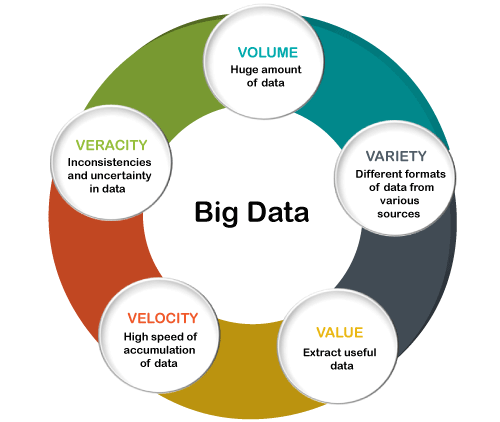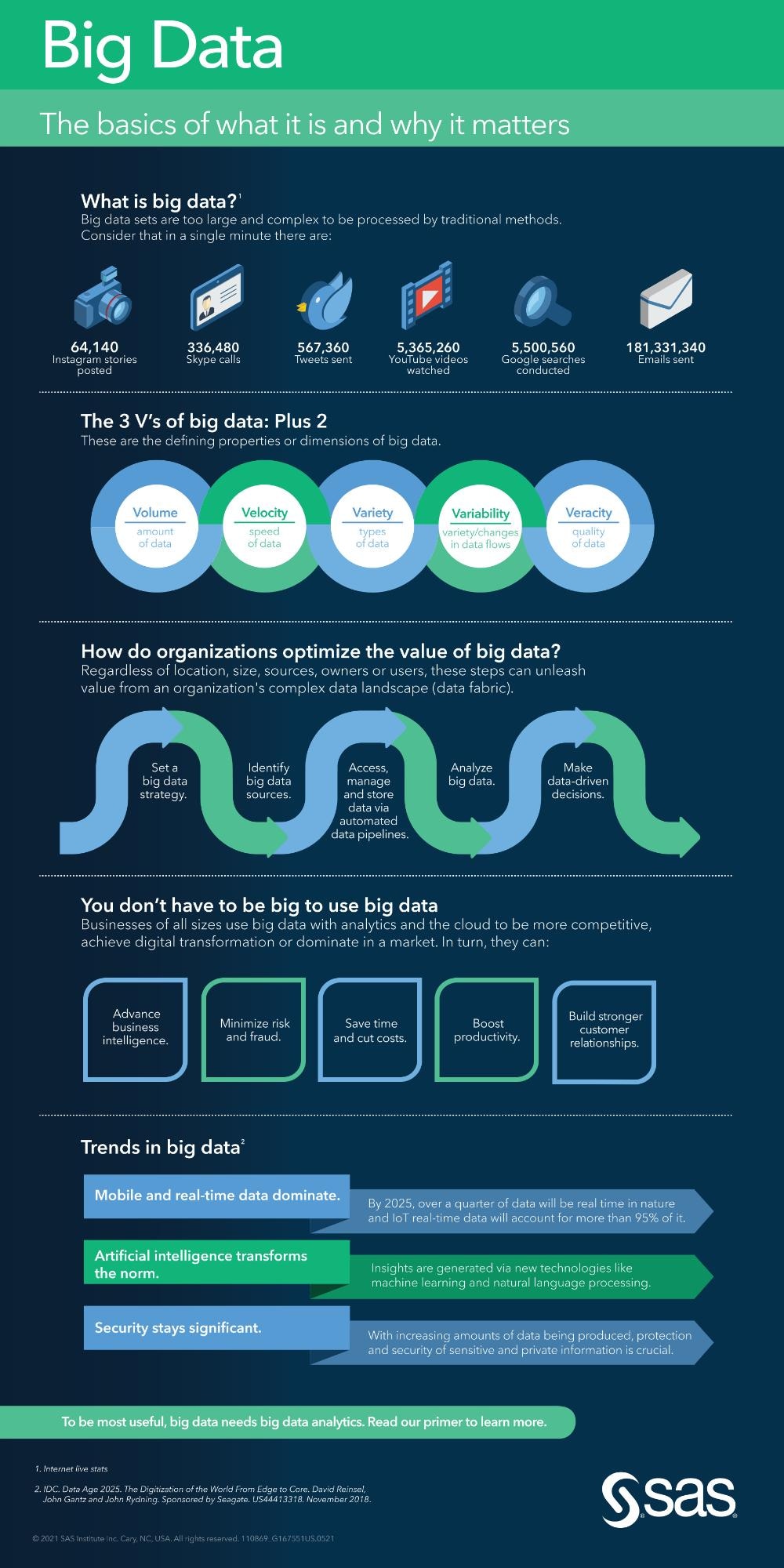Big Data Describes the Vast Amounts of Both
Never before in the history of humanity has there been so much information being collected studied and used daily. The four Vs distinguish and define big data and describe its challenges.

Big Data Characteristics Javatpoint
Organizations that are able to harness the power of big data can drive both operational efficiency and quality leading to cost and labor.

. Big Data could be 1 Structured 2 Unstructured 3 Semi-structured. Thus the Volume characteristic is the defining criterion for whether we can consider a dataset can be regarded as Big Data or not. Big data is a term that describes large hard-to-manage volumes of data both structured and unstructured that inundate businesses on a day-to-day basis.
State and explain the characteristics of Big Data. Volume variety velocity and veracity. The amount of data created every 48 hours is equivalent to the.
We already know that Big Data indicates huge volumes of data that is being generated on a daily basis from various sources like social media platforms business processes machines networks human interactions etc. True The move toward access instead of ownership is a sign of cognitive surplus. Texting tweeting and browsing the web on a daily basis c.
But its not just the type or amount of data thats important its what organizations do with the data that matters. Volume is one of the characteristics of big data. Which of the following examples best describes big data.
Big data is new and ginormous and scary very very scary. Big Data meaning a data that is huge in size. The vast amount of data that must be dealt with.
Five hundred cell-phone owners around the world generate vast amounts of data by calling. A datasets with fewer than a billion records. Increase in the amount of data stored.
Big data refers to data sets that are too large or complex to be dealt with by traditional data-processing application softwareData with many fields rows offer greater statistical power while data with higher complexity more attributes or columns may lead to a higher false discovery rate. Access the vast amounts of data in a data. Big Data is the broad term used for data sets very complex or large that conventional data processing applications are insufficient.
A data element can measure the an event eg. Facebook processes one thousand picture uploads per day b. What is the Measure.
Big Data describes the large volume of data both structured semi-structured and unstructured that is collected by a business on a daily basis. 2 everything you need to know about big data 3 industry uses of large amount of data 4 challenges associated with. These processes use familiar statistical analysis techniqueslike clustering and regressionand apply them to more extensive datasets with the help of newer tools.
The challenges include capture analysis data curation sharing searching storage visualization transfer as well as. Big data analysis challenges include capturing data data storage data analysis search. Describe at least three sources of Big Data.
Big Data refers to data volumes that are so complex that conventional software and hardware used for processing data is no longer of any use. This data can be generated by both humans such as a customers financial transactions as well as by machines and processes such as sensor readings and event logs. First watch the following video that briefly describes big data and some of its benefits.
The term Big Data describes the massive amounts of data being collected in todays networked digitized sensor-populated and information-driven world and the tools used to analyze and extract information from these large and complex data sets. Big data is just another name for the same old data marketers have always used and its not all that big and its something we should be embracing not. This means that at its essence Big Data is a neutral term as its also used to describe harmless quantities of data that can be observed in research or other non-commercial environments.
Lets start with the chief characteristic especially since Big Data was first coined to describe the enormous amount of information. Big data describes the vast amounts of both structured and unstructured data that is generated daily. In this article we discuss 1 what is Big Data and what it does.
Big Data analytics examples includes stock exchanges social media sites jet engines etc. 4 Vs of Big Data. Velocity speed of the data Volume Scale of the data.
Big Data definition. Machine Learning Is Not Rocket Science Part 1 Machine Learning Learning Rocket Science What Are Real Life Applications Of Big Data Analytics Data Analytics Big Data Big Data Analytics. However the definition of Big Data can.
Big data datasets that are too large to be gathered stored managed and analyzed by typical database software tools can generate plenty of value for organizations of all sizes and types. Big data analytics describes the process of uncovering trends patterns and correlations in large amounts of raw data to help make data-informed decisions. Businesses have grappled with the ever-increasing amounts of data for years.
Volume describes both the size and quantity of the data. The 4Vs is a data management trend that was conceived to help organisations realise and cope with the emergence of big data. Variety Diversity of the data.
The term big data refers to all of the following except. Data is streaming from all aspects of our lives in unprecedented amounts. The most well-known characteristic of big data is the volume generated.
Archives Machine logs Public Web Sensor Data Social Media. B users to view both logical and physical views of data. C programmers to quickly diagram data relationships.
Purchase or an entity eg. Bigdata is a term used to describe a collection of data that is huge in size and yet growing exponentially with time. Big data is a term that describes large hard-to-manage volumes of data both structured and unstructured that inundate businesses on a day-to-day basis.
How is the measure being measured the vast majority of data analytic techniques make measurement scale assumptions - it is essential to. Big data can be understood as the convergence of four dimensions or the four Vs. Users to obtain online answers to ad-hoc questions in a rapid amount of time.
Data professionals describe big data by the four Vs. These characteristics are what make big data a big deal. A collection of data sources inside and outside your company that represents a source for ongoing discovery and analysis.

Big Data What It Is And Why It Matters Sas India

Big Data The 3 Vs Explained Big Data Ldn


No comments for "Big Data Describes the Vast Amounts of Both"
Post a Comment